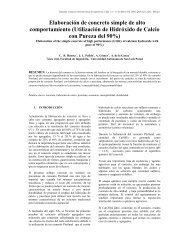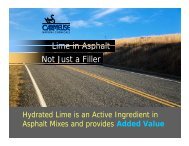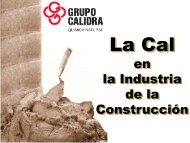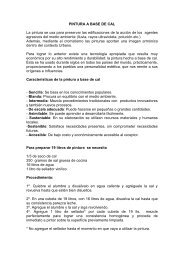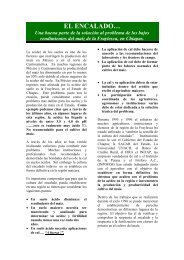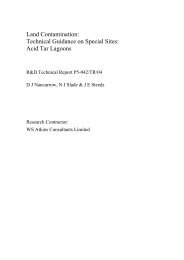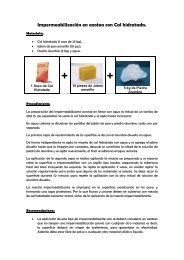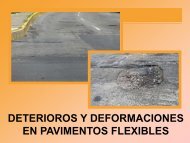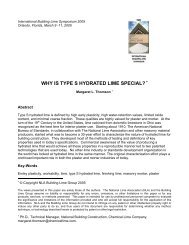USING LIME FOR SOIL STABILIZATION AND MODIFICATION A ...
USING LIME FOR SOIL STABILIZATION AND MODIFICATION A ...
USING LIME FOR SOIL STABILIZATION AND MODIFICATION A ...
Create successful ePaper yourself
Turn your PDF publications into a flip-book with our unique Google optimized e-Paper software.
Updated March 2001Page 2Pennsylvania, for example, began with a $29.3 million traditional design approach. An alternatedesign using lime stabilization, consistent with AASHTO mechanistic-empirical designs, cost only$21.6 million—more than 25 percent savings! (Qubain et al., Incorporating Subgrade LimeStabilization into Pavement Design, Transportation Research Board Meeting, January 2000.)• In the longer term, lime stabilization provides performance benefits that reduce maintenance costs.To illustrate, stabilizing an 8-inch native clay subgrade with lime as part of an asphalt pavementproject can reduce 30-year life cycle costs from $24.49 to $22.47 per square yard (from a life cyclemethodology illustration in Stabilization of Pavement Subgrades & Base Courses with Lime, seebelow).In addition to stabilization of new materials, lime is an excellent choice for the reclamation ofroadbases. As more and more governmental entities are choosing to reclaim existing roadbases ratherthan replace them, this use of lime will become even more important.Lime stabilization is not difficult to carry out. After proper mix design and testing is performed, inplacemixing is usually used to add the appropriate amount of lime to soil, mixed to an appropriatedepth. Pulverization and mixing is used to thoroughly combine the lime and soil. For heavy clays,preliminary mixing may be followed by 24 to 48 hours (or more) of moist curing, followed by finalmixing. For maximum development of strength and durability, proper compaction is necessary.Proper curing is also important. If sulfates are present at levels greater than 0.3 percent, specialprocedures are required.Additional details on mixture design and testing protocols appear in NLA’s Evaluation of StructuralProperties of Lime Stabilized Soils and Aggregates, Volume 3: Mixture Design and Testing Protocolfor Lime Stabilized Soils, by Dr. Dallas N. Little of Texas A&M University (see reference list below).Other methods of lime stabilization include in-plant mixing and pressure injection.For more information, including technical papers on soil stabilization, check NLA’s website athttp://www.lime.org. Several useful documents can be downloaded free of charge and others can beordered online, including:• Evaluation of Structural Properties of Lime Stabilized Soils and Aggregates (3 volumes)• Fundamentals of the Stabilization of Soil with Lime• Lime Stabilization Construction Manual• Guidelines for Stabilization of Soils Containing Sulfates• A Long Range Durability Study of Lime Stabilized Bases• Lime Slurry Pressure Injection Manual• Stabilization of Pavement Subgrades & Base Courses with Lime• Lime Dries Up MudNational Lime Association200 N. Glebe Road, Suite 800Arlington, Virginia 22203-3728Phone: 703-243-5463; Fax: 703-243-5489E-Mail: natlime@lime.orgWeb Address: http://www.lime.org



